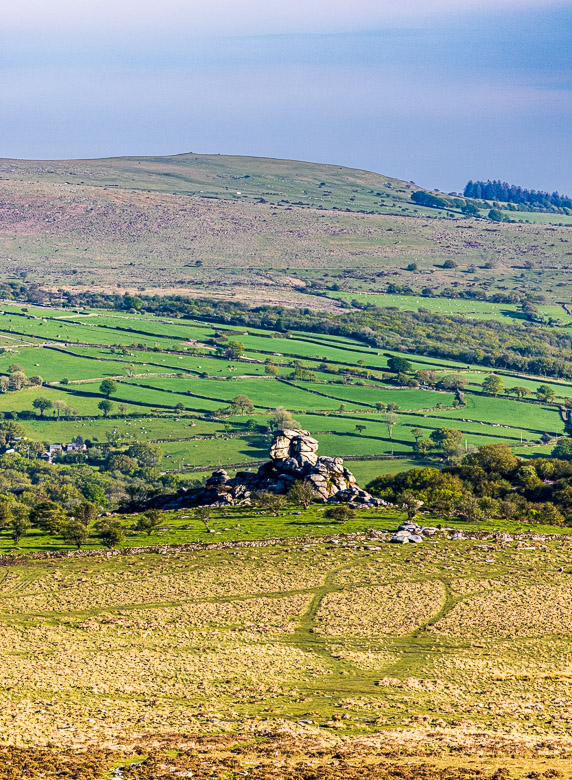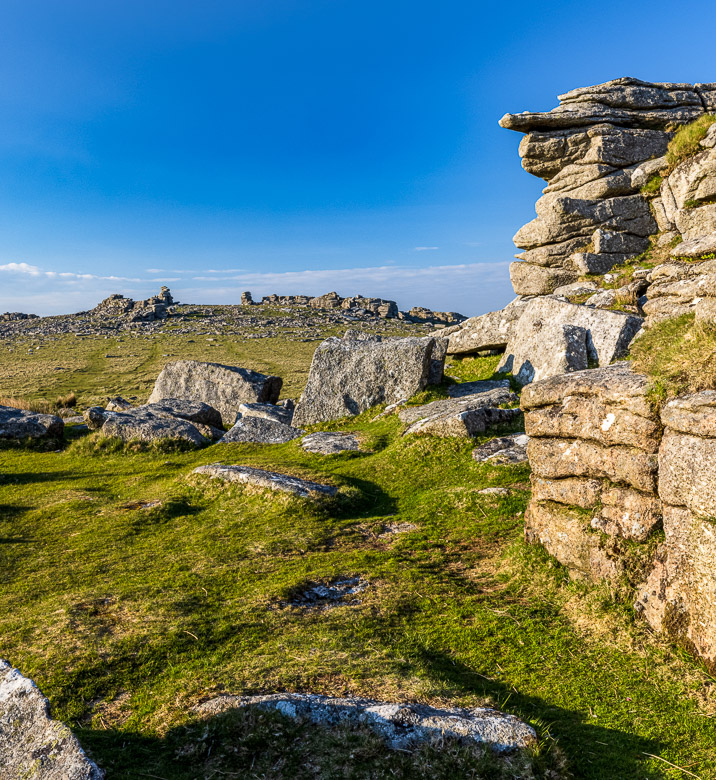
Great Staple Tor is one of the impressive Tors on Dartmoor with dramatic rock formations. But it is also a tor at high altitude (455 m) that shows the vastness of the bleak surrounding moorland, and I climbed up to illustrate just this character of the moorland. But I am such a positive person that I am not the best photographer to illustrate the bleakness of Dartmoor. In my Dartmoor the sun is shining a lot and nature is smiling back at me!
There are actually three Staple Tors, Little Staple Tor, Middle Staple Tor and Great Staple Tor. You approach first the Little Staple Tor at an altitude of 380 m and then try to find a path to Middle Staple Tor at 430 m. It is actually quite tricky to walk due to all the clitter (granite stones of different sizes covering the ground) spread out over the ground. The images below shows the view looking south from Little and Middle Staple Tors.
The vastness of the landscape is clearly seen in the images. You can understand that when Dartmoor is blanketed in fog, and before the time of smartphones and GPS navigation, it was easy to get lost here. Looking in between the boulders from Little Staple Tor and to the left of the image of Middle Staple Tor is Vixen Tor. It is further down in the valley at only 310 m altitude and the only tor I have walked down to reach. The image below shows Vixen Tor captured with a tele lens. It looked so special in my camera lens that I decided to pay a separate visit to Vixen Tor with my daughter Mikee, and I publish some images from Vixen Tor in my next post.

Looking north from Middle Staple Tor (at 430 m alt) you see Great Staple Tor (at 455 m alt) in the image below. You can clearly see the stacks or steeples sticking up above the horizon at the tor. The name Great Staple Tor came when the cartographers doing the Ordnance Survey Map misinterpreted the name Great Steeple Tor and it became instead “Staple”.



The two previous images show the views looking north and east from Great Staple Tor. The very first image in this post showed the sunset looking west northwest. Straight below the sun is Brent Tor. On top of Brent Tor is the parish church of Brentor village. If you can blow up the image large enough, the church can be discerned 8.5 km away (as the crow flies).
Brent Tor is quite unique. Whereas all the other Tors are built up of granite, Brent Tor is composed of basaltic lava from an old volcano erupting under a former sea around 350 million years ago. On top of the Tor the Church of St Michael de Rupe (St Michael of the Rocks) was built. The church raises 40 feet above the top of the Tor making it the most iconic silhouette on Dartmoor. It was founded in 1130 and it is still a working church, although normal Sunday Services are held down in the village of Brentor, where there is another village church as well. The present church dates mostly from the 13th and 14th centuries.
My final image on this post was captured at Brent Tor in November last year. It had been raining most of the afternoon and as the low pressure past, the wind increased to half storm and the rain whipped my face, but I was waiting in the hope of the sun breaking through those clouds. And I was rewarded, and soaked with rain I pressed the remote to release the shutter and got the image below. Ten minutes later the sun was again hidden in clouds and stayed that way until sunset. But a short moment is all you need, if you are prepared.



